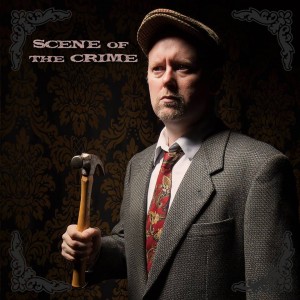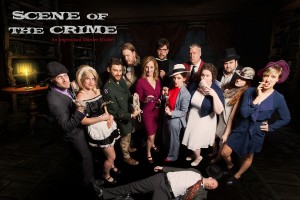See Scene of the Crime every Saturday in May and June! Get your tickets here!
by Scene of the Crime director Troy Miller
 A few years ago, I got to bring an improv dream of mine to life at The Hideout Theatre. It was “Hitchcocked!” and, as the title should suggest, we performed a never-before-seen Alfred Hitchcock film on stage. The chief goal of the show was to work the skill of suspense: how to create it, sustain it, and allow the audience to experience it as the main character does.
A few years ago, I got to bring an improv dream of mine to life at The Hideout Theatre. It was “Hitchcocked!” and, as the title should suggest, we performed a never-before-seen Alfred Hitchcock film on stage. The chief goal of the show was to work the skill of suspense: how to create it, sustain it, and allow the audience to experience it as the main character does.
This was what Hitchcock himself set out to achieve in his films. He wanted the audience to know more than the hero, so that as that character moved through the plot unaware, Hitch could ratchet up the tension to unbearable heights. He had no time for mystery, and yet his body of work is often to this day mischaracterized as such.
“Hitchcocked!” was about suspense. “Scene of the Crime” is firmly about mystery. And getting to bring it to life is another improv dream of mine. I remember seeing the BATS improv company in San Francisco do an improvised murder mystery several years ago, and that’s when I knew it could actually be done. They did it so well, in fact, that there was one key technique they used that I knew I wanted to try whenever I got the chance… but you’ll have to come see the show to discover what that is!
“Scene of the Crime” is inspired by the kind of isolated location whodunnits that Agatha Christie was so famous for writing. In those stories, a group of eclectic characters find themselves suspects in a murder. Each knew the victim, each had a motive. But somehow cut off from the authorities (because of, say, a snow storm), a detective who just happens to also be there (a real sleuth or someone who’s just got a knack for it) is called into action.

If you’ve seen her play “Mousetrap” or read “Murder on the Orient Express” or seen any one of the countless screen or television adaptations of her work, you’ll know exactly what I’m talking about. Hers is the kind of mystery tale in short supply these days. The “action” of the story is more cerebral. Instead of shoot outs and chases, we get to see a puzzle box be constructed, twisted about, then broken back down to reveal layers of deceit, until the real truth is uncovered. Though different in form, Ira Levin’s “Deathtrap” also wonderfully captures that spirit in its tone. Nothing is what it seems, and everyone is on his or her best behavior—until the ruse is up.
When all is said and done, our hope is to exude with heart and zest this more classic style of murder mystery, with the audience jovially sleuthing it up right along with our intrepid detective. If conversations in the lobby at intermission contain phrases like “Well, it couldn’t have been her, because…”, or “Yes, he’s definitely hiding something…”, then we would be perfectly, diabolically delighted.
